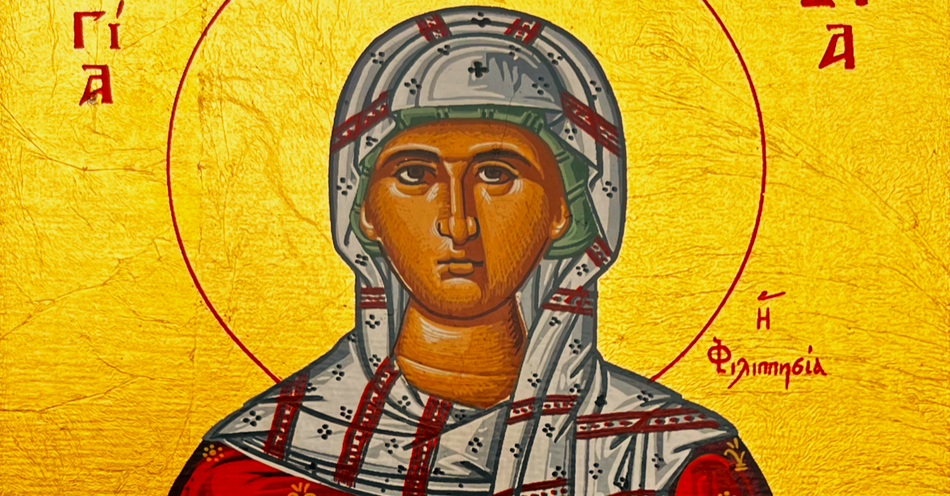In the Acts of the Apostles, Lydia stands out as vividly as the luxurious purple cloth she wove to earn a livelihood. She was the head of her household and the gracious hostess of a new Christian church meeting in her home. In this way, she bolstered Christianity’s growth in the Gentile world, aiding the efforts of Paul, Timothy, and Silas.
Granted, we don’t know as much about her as we would like. The Acts 16 reference to her is brief, and her name appears to be generic, the same as the region where she was born. Still, the fact she is named at all makes her more prominent than the many unnamed women and men in the Bible. As we will see, her example empowers modern women and men to use their gifts, prosper, and confidently serve the Lord.
Where Does the Bible Mention Lydia Meeting Paul?
Acts 16:13-15 briefly explains how Lydia met Paul, accepted his invitation to become a Christian, and led her people to join the faith journey. Lydia’s narrative takes place at the beginning of Paul’s second missionary trip, which scholars estimate happened in 50 AD. During this trip, he sailed from the coast of Asia Minor to southern Europe, his first time on the European mainland.
Paul was inspired by a vision in a dream to spread the good news of the Gospel to Macedonia (Acts 16:10-11). Accompanied by Luke (who penned the gospel of Luke and is also believed to have recorded Acts) and other evangelists, Paul sailed across the Aegean sea from Troas in Asia Minor to Neapolis, a port city serving the Roman colony of Philippi in Macedonian territory. From Neapolis, Paul, Silas, and Luke walked the Via Egnatia to Philippi (Acts 16:12).
Philippi was originally a Greek city that Philip of Macedon conquered in 300 BC. It became a busy commercial center after Roman soldiers and their families resettled it in the first century BC. Luke wrote in Acts 16:12 that it was the “leading city” of that district of Macedonia, referring perhaps to its mining of gold and manufacturing of gold coins.
Acts 16:13-15 tells how there were few Jews and no synagogue in Philippi when Paul and his companions arrived on a Sabbath day. They “expected to find a place of prayer” at the river outside a city gate, where women gathered. The apostles spoke to the women at the river about Christ. One of the listeners was Lydia, a dealer in purple cloth purchased and worn by wealthy, noble Roman citizens.
What Does Acts Tell Us about Lydia?
Luke records that Lydia is from Thyatira, a Roman province in Asia Minor. During the first century AD, Thyatira was a hub for the purple cloth trade, with a cloth dyers’ guild. Lydia is, therefore, an immigrant living in Philippi. BibleJourney suggests that she was probably the widow or daughter of a wealthy man who founded the purple cloth business. She may also have been an “overseas agent” for a Thyatira cloth manufacturer.
Lydia’s character is as precious as her cloth dye, made from thousands of shellfish. She is described as a spiritual person when she meets Paul and his associates at the river. Given the Greek culture of the time, she was most likely a polytheist. Yet, she readily accepts Paul’s invitation to become a Christian. In Acts 16:14-15 it says, “She was a worshiper of God. The Lord opened her heart to respond to Paul’s message.”
Lydia’s heart expanded even further when she encouraged members of her household to be baptized and join in her faith journey. Not stopping there, she invites Paul and the other apostles to establish a church in her home: ‘If you consider me a believer in the Lord,’ she said, ‘come and stay at my house.’ And she persuaded us,” Luke wrote in Acts 16:15. Lydia opened her heart and home to Christianity. Her large townhouse became the new church’s headquarters in Philippi.
Why Was Lydia An Important Convert to Christianity?
Lydia is cited as the first convert to Christianity in what we now call Europe. And she immediately acts as an evangelist, following Christ’s instruction to “Go and make disciples of all men” (Matthew 28:19-20). She calls members of her household to join her on her faith journey and invites the new church to take residence in her home. Dictionary of Paul and His Letters explains that a patron of the church that formed in Philippi, she did “far more than serving coffee to her guests or provide cash to cover expenses . . . Homeowners in Greco-Roman times were in charge of all groups that met under their roof.”
To understand how large Lydia’s household may have been, Dictionary of Paul and His Letters explains that in Acts 16:15, the words “household” and “home” are translated from the Greek word oikos. An oikos included spouses, children, household servants or slaves, laborers, and even business associates. The oikos shared “common economic, social, psychological, and religious factors,” creating a secure identity and sense of belonging.
Lydia could also have been a spiritual leader in her household. First-century Jewish women played a subservient role in the synagogue and domestic life. However, Gentile women in Roman territories often had larger roles—pagan women led polytheistic cults, and Christian women preached and taught in Christian communities.
Why Is It Important that Lydia Made Purple Cloth for a Living?
Lydia’s large oikos could rest secure in her solid financial standing as a producer of purple cloth worn by royalty and priests.
As Mike Leak reports, purple was a regal and valuable cloth color. As the Holman Illustrated Bible Dictionary explains, purple was a symbol of luxury and elegance. We see this clearly when a description about God blessing artists to make the tabernacle highlights purple and scarlet cloth:
“He has filled them with skill to do all kinds of work as engravers, designers, embroiderers in blue, purple and scarlet yarn and fine linen, and weavers—all of them skilled workers and designers.” (Exodus 35:35)
Add to that the expensive process to make it from shellfish, and it was an expensive item. Selling purple cloth likely made Lydia wealthy. As Gordon D. Fee wrote in The Letter to the Philippians, Lydia’s successful business would have furnished her with a villa to accommodate her oikos as well as Paul’s church.
In “Was Lydia a Leader of the Church in Philippi?”, Peter Foxwell wrote about how Lydia’s role may not have been unusual since “women could indeed play a prominent role in Roman society. Ancient writing in inscriptions recovered from Philippi and other Roman cities suggests that women of various social classes held civic offices, accumulated wealth, and owned or managed . . . merchant ships.” They financed public works such as statues, buildings, and marketplaces and could even command armies.”
What Can We Learn from Lydia Today about Supporting Missions?
While Acts 16 doesn’t give a precise time frame for Lydia’s actions, it suggests she acted quickly and decisively. She used her bountiful gifts and faith in God without hesitation. Churches today can heed her example: after a committee meets, it is time to carry out church missions without delay.
Lydia did function as chairman of a “committee,” however. She enlisted her family, employees, and other associates in building the new Christian church. Her example teaches us that we are not meant to be private agents acting alone, but rather part of the body of Christ, with each member using its gifts and understanding of the situation at hand (I Corinthians 12:27). Leaders such as Lydia, step forward, and followers do much of the footwork.
Lydia’s example also teaches us to support our churches by giving generously and spending the fortune we earn using God-given talents. Lydia clearly believed that “Every good and perfect gift comes from above” (James 1:17). She did not hoard her wealth or restrict its use to her oikos members. I imagine she did not live in decadent luxury herself, either. This reminds me that to whom much is given, much is expected (Luke 12:48). God expects us to serve His church and other people with our bounty.
What Can We Learn Today from Lydia about Women in the Church?
Paul follows Jesus’ example in respecting and appreciating Lydia’s gifts. Jesus’ band of disciples included women—among them his mother, Salome, Mary Magdalene, and the mother of James and John. Many women apostles worked to build the new church after His resurrection.
Jesus treated the women he met in his ministry with love and respect. He healed women and men alike. This treatment of Jesus did not follow traditional Jewish customs, which considered women second-class citizens. He left a legacy in Scripture to treat all people equally. When Jesus spoke to the woman at the well and healed the persistent woman of her twelve-year hemorrhage, he saw only a person needing His mercy. Women in church today may take leadership roles and speak with confidence. Jesus approves.
As a strong Christian woman, Lydia wove together the body of Christ, one thread at a time, like her beautiful purple cloth. She gave her life to Christ, was baptized, gathered her oikos with her, and eagerly and courteously provided a home for the apostles spreading the gospel. She was endowed with plentiful gifts, which she shared openly with the growing Christian church in the first century.
Today, a building called Lydia's Church stands beside the River Zygaktis, where archeologists believe Paul and his accomplices baptized Lydia. Lydia is esteemed as a saint in the Roman Catholic church, and Anglican, Episcopal, and several Orthodox churches observe her name day. Her brief appearance in scripture resonates today as an example of a strong Christian woman.
Photo Credit: Wikimedia Commons/Dr. med. Detlef Bihn, photo edited by G. Connor Salter

This article is part of our People of Christianity catalog that features the stories, meaning, and significance of well-known people from the Bible and history. Here are some of the most popular articles for knowing important figures in Christianity:
How Did the Apostle Paul Die?
Who are the Nicolaitans in Revelation?
Who Was Deborah in the Bible?
Who Was Moses in the Bible?
King Solomon's Story in the Bible
Who Was Lot's Wife in the Bible?
Who Was Jezebel in the Bible?
Who Was the Prodigal Son?


.jpg)
